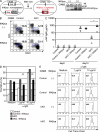CIN85 drives B cell responses by linking BCR signals to the canonical NF-kappaB pathway
- PMID: 21708930
- PMCID: PMC3135365
- DOI: 10.1084/jem.20102665
CIN85 drives B cell responses by linking BCR signals to the canonical NF-kappaB pathway
Abstract
CIN85, an adaptor protein which binds the C-terminal domain of tyrosine phosphorylated Cbl and Cbl-b, has been thought to be involved in the internalization and subsequent degradation of receptors. However, its physiological function remains unclear. To determine its role in B cells, we used Mb1-cre to generate mice with a B cell-specific deletion of CIN85. These mice had impaired T cell-independent type II antibody responses in vivo and diminished IKK-β activation and cellular responses to B cell receptor (BCR) cross-linking in vitro. Introduction of a constitutively active IKK-β construct corrected the defective antibody responses as well as cellular responses in the mutant mice. Together, our results suggest that CIN85 links the BCR to IKK-β activation, thereby contributing to T cell-independent immune responses.
Figures






Similar articles
-
The B-cell antigen receptor signals through a preformed transducer module of SLP65 and CIN85.EMBO J. 2011 Aug 5;30(17):3620-34. doi: 10.1038/emboj.2011.251. EMBO J. 2011. PMID: 21822214 Free PMC article.
-
CIN85 is required for Cbl-mediated regulation of antigen receptor signaling in human B cells.Blood. 2012 Mar 8;119(10):2263-73. doi: 10.1182/blood-2011-04-351965. Epub 2012 Jan 18. Blood. 2012. PMID: 22262777
-
Bruton's tyrosine kinase is required for activation of IkappaB kinase and nuclear factor kappaB in response to B cell receptor engagement.J Exp Med. 2000 May 15;191(10):1745-54. doi: 10.1084/jem.191.10.1745. J Exp Med. 2000. PMID: 10811867 Free PMC article.
-
Roles of the NF-κB Pathway in B-Lymphocyte Biology.Curr Top Microbiol Immunol. 2016;393:177-209. doi: 10.1007/82_2015_479. Curr Top Microbiol Immunol. 2016. PMID: 26275874 Review.
-
Comprehending the complex connection between PKCbeta, TAK1, and IKK in BCR signaling.Immunol Rev. 2009 Nov;232(1):300-18. doi: 10.1111/j.1600-065X.2009.00836.x. Immunol Rev. 2009. PMID: 19909372 Review.
Cited by
-
Mechanisms of central tolerance for B cells.Nat Rev Immunol. 2017 May;17(5):281-294. doi: 10.1038/nri.2017.19. Epub 2017 Apr 3. Nat Rev Immunol. 2017. PMID: 28368006 Free PMC article. Review.
-
Germline deletion of CIN85 in humans with X chromosome-linked antibody deficiency.J Exp Med. 2018 May 7;215(5):1327-1336. doi: 10.1084/jem.20170534. Epub 2018 Apr 10. J Exp Med. 2018. PMID: 29636373 Free PMC article.
-
Sprouty1 induces a senescence-associated secretory phenotype by regulating NFκB activity: implications for tumorigenesis.Cell Death Differ. 2014 Feb;21(2):333-43. doi: 10.1038/cdd.2013.161. Epub 2013 Nov 22. Cell Death Differ. 2014. PMID: 24270409 Free PMC article.
-
Conversion of T cells to B cells by inactivation of polycomb-mediated epigenetic suppression of the B-lineage program.Genes Dev. 2016 Nov 15;30(22):2475-2485. doi: 10.1101/gad.290593.116. Epub 2016 Dec 2. Genes Dev. 2016. PMID: 27913604 Free PMC article.
-
The adaptor molecule CD2AP in CD4 T cells modulates differentiation of follicular helper T cells during chronic LCMV infection.PLoS Pathog. 2018 May 7;14(5):e1007053. doi: 10.1371/journal.ppat.1007053. eCollection 2018 May. PLoS Pathog. 2018. PMID: 29734372 Free PMC article.
References
Publication types
MeSH terms
Substances
LinkOut - more resources
Full Text Sources
Molecular Biology Databases
Miscellaneous

